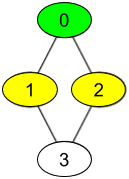C++
Java
Python
Python3
C
C#
JavaScript
Ruby
Swift
Go
Scala
Kotlin
Rust
PHP
TypeScript
Racket
Erlang
Elixir
Dart
monokai
ambiance
chaos
chrome
cloud9_day
cloud9_night
cloud9_night_low_color
clouds
clouds_midnight
cobalt
crimson_editor
dawn
dracula
dreamweaver
eclipse
github
github_dark
gob
gruvbox
gruvbox_dark_hard
gruvbox_light_hard
idle_fingers
iplastic
katzenmilch
kr_theme
kuroir
merbivore
merbivore_soft
mono_industrial
nord_dark
one_dark
pastel_on_dark
solarized_dark
solarized_light
sqlserver
terminal
textmate
tomorrow
tomorrow_night
tomorrow_night_blue
tomorrow_night_bright
tomorrow_night_eighties
twilight
vibrant_ink
xcode
上次编辑到这里,代码来自缓存 点击恢复默认模板
class Solution {
public:
vector<string> watchedVideosByFriends(vector<vector<string>>& watchedVideos, vector<vector<int>>& friends, int id, int level) {
}
};
运行代码
提交
golang 解法, 执行用时: 80 ms, 内存消耗: 7.2 MB, 提交时间: 2023-09-23 10:56:29
// bfs
func watchedVideosByFriends(watchedVideos [][]string, friends [][]int, id int, level int) []string {
visited := make(map[int]bool)
videos := make(map[string]int)
queue := []int{id}
visited[id] = true
for len(queue) > 0 {
level--
length := len(queue)
for _, i := range queue {
for _, j := range friends[i] {
if !visited[j] {
visited[j] = true
queue = append(queue, j)
if level == 0 {
for _, v := range watchedVideos[j] {
videos[v]++
}
}
}
}
}
if level == 0 {
break
}
queue = queue[length:]
}
res := make([]string, 0, len(videos))
for k := range videos {
res = append(res, k)
}
sort.Slice(res, func(i, j int) bool {
return videos[res[i]] < videos[res[j]] || videos[res[i]] == videos[res[j]] && res[i] < res[j]
})
return res
}
golang 解法, 执行用时: 64 ms, 内存消耗: 7.3 MB, 提交时间: 2023-09-23 10:56:00
func watchedVideosByFriends(watchedVideos [][]string, friends [][]int, id int, k int) []string {
kfriend := []int{}
queue := []int{id}
visited := make(map[int]bool)
visited[id] = true
step := 0
for len(queue)!=0{
if step == k{
kfriend = queue
break
}
tmp := queue
queue = nil
for _,c:=range tmp{
for _,f:=range friends[c]{
if !visited[f]{
visited[f] = true
queue = append(queue,f)
}
}
}
step ++
}
if kfriend == nil{
return nil
}
mp := make(map[string]int)
ans :=[]string{}
for _,f:=range kfriend{
for _,s:=range watchedVideos[f]{
mp[s]++
if mp[s]==1{
ans = append(ans,s)
}
}
}
sort.Slice(ans,func(i,j int)bool{
if mp[ans[i]]==mp[ans[j]]{
return ans[i]<ans[j]
}
return mp[ans[i]]<mp[ans[j]]
})
return ans
}
java 解法, 执行用时: 32 ms, 内存消耗: 44.2 MB, 提交时间: 2023-09-23 10:55:25
class Solution {
public List<String> watchedVideosByFriends(List<List<String>> watchedVideos, int[][] friends, int id, int level) {
int n = friends.length;
boolean[] visited = new boolean[n];
Map<String, Integer> map = new HashMap<>();
Queue<int[]> queue = new LinkedList<>();
queue.offer(new int[]{id, 0});
visited[id] = true;
while (queue.size() > 0) {
int[] poi = queue.poll();
if (poi[1] < level) {
for (int friend : friends[poi[0]]) {
if (visited[friend]) continue;
visited[friend] = true;
queue.offer(new int[]{friend, poi[1]+1});
}
} else {
List<String> videos = watchedVideos.get(poi[0]);
for (String video : videos) {
int count = map.getOrDefault(video, 0)+1;
map.put(video, count);
}
}
}
List<String> res = new ArrayList<>();
for (String key : map.keySet()) {
res.add(key);
}
res = res.stream().sorted((x, y)->{
if (map.get(x) == map.get(y)) {
return x.compareTo(y);
} else {
return map.get(x) - map.get(y);
}
}).collect(Collectors.toList());
return res;
}
}
python3 解法, 执行用时: 80 ms, 内存消耗: 18 MB, 提交时间: 2023-09-23 10:55:06
class Solution:
def watchedVideosByFriends(self, watchedVideos: List[List[str]], friends: List[List[int]], id: int, level: int) -> List[str]:
n = len(friends)
used = [False] * n
q = collections.deque([id])
used[id] = True
for _ in range(level):
span = len(q)
for i in range(span):
u = q.popleft()
for v in friends[u]:
if not used[v]:
q.append(v)
used[v] = True
freq = collections.Counter()
for _ in range(len(q)):
u = q.pop()
for watched in watchedVideos[u]:
freq[watched] += 1
videos = list(freq.items())
videos.sort(key=lambda x: (x[1], x[0]))
ans = [video[0] for video in videos]
return ans
cpp 解法, 执行用时: 88 ms, 内存消耗: 36.5 MB, 提交时间: 2023-09-23 10:54:47
using PSI = pair<string, int>;
class Solution {
public:
vector<string> watchedVideosByFriends(vector<vector<string>>& watchedVideos, vector<vector<int>>& friends, int id, int level) {
int n = friends.size();
vector<bool> used(n);
queue<int> q;
q.push(id);
used[id] = true;
// 1. 找出所有 Level k 的好友
for (int _ = 1; _ <= level; ++_) {
int span = q.size();
for (int i = 0; i < span; ++i) {
int u = q.front();
q.pop();
for (int v: friends[u]) {
if (!used[v]) {
q.push(v);
used[v] = true;
}
}
}
}
// 2. 统计好友观看过的视频
unordered_map<string, int> freq;
while (!q.empty()) {
int u = q.front();
q.pop();
for (const string& watched: watchedVideos[u]) {
++freq[watched];
}
}
// 3. 将视频按照要求排序
vector<PSI> videos(freq.begin(), freq.end());
sort(videos.begin(), videos.end(), [](const PSI& p, const PSI& q) {
return p.second < q.second || (p.second == q.second && p.first < q.first);
});
vector<string> ans;
for (const PSI& video: videos) {
ans.push_back(video.first);
}
return ans;
}
};

